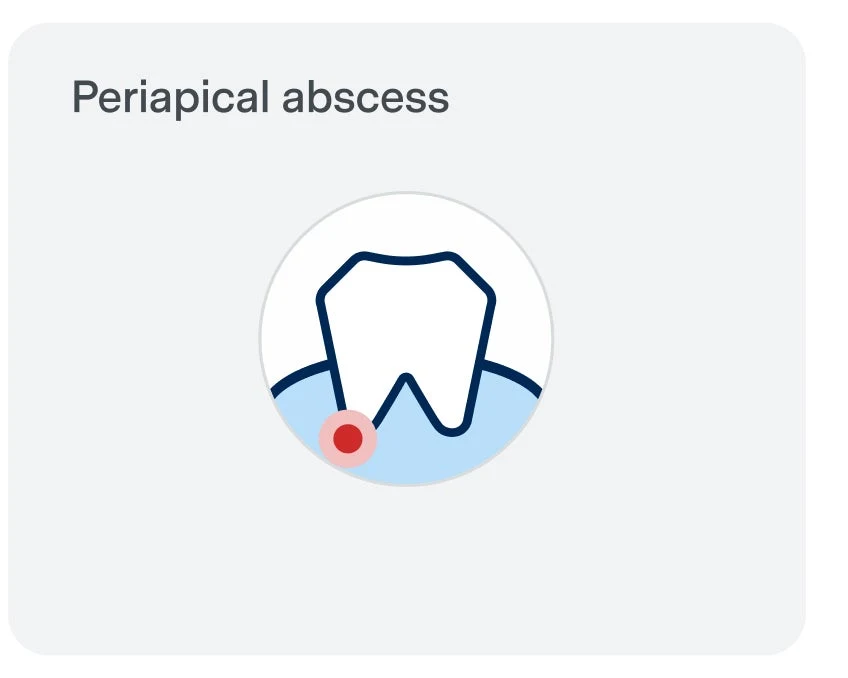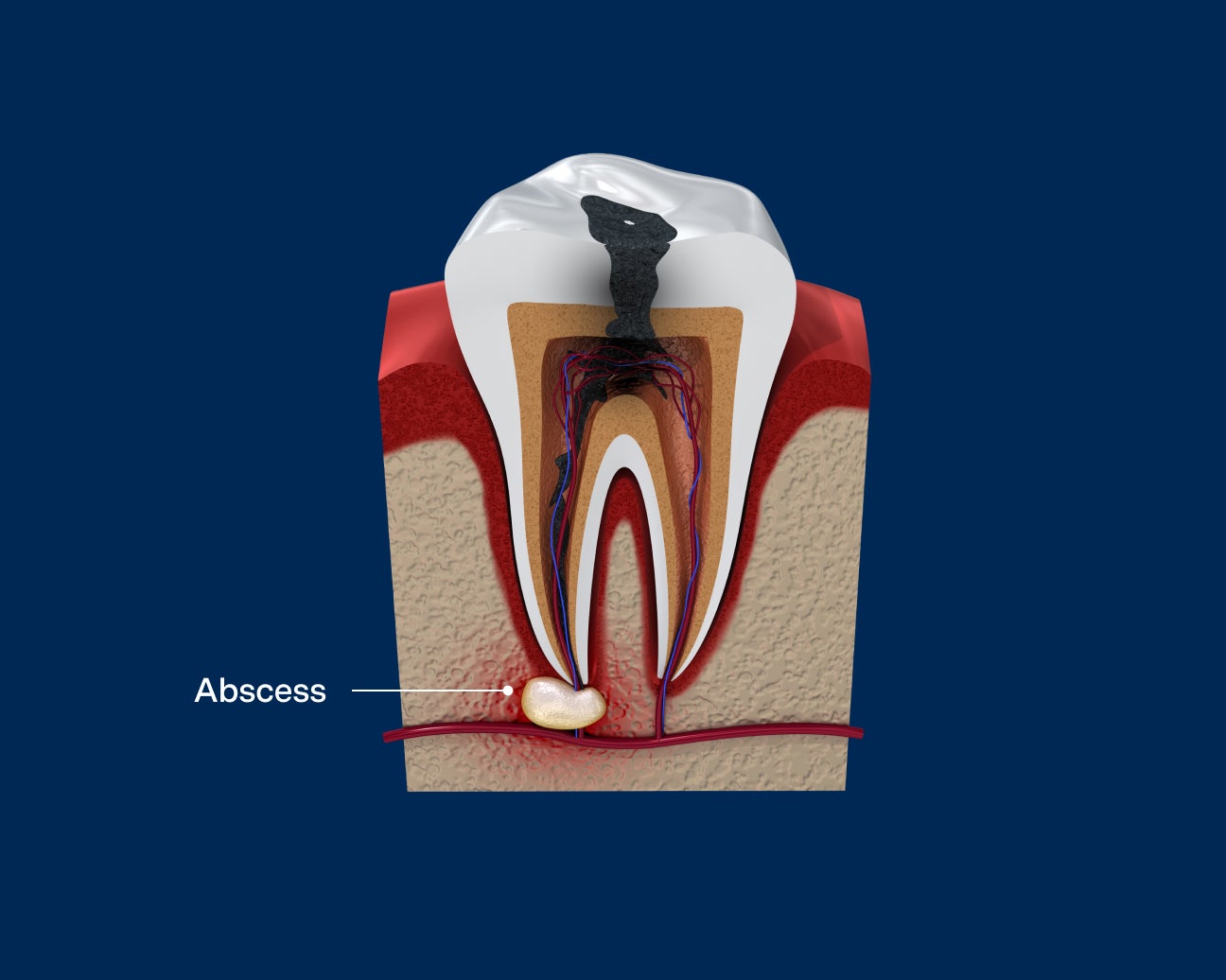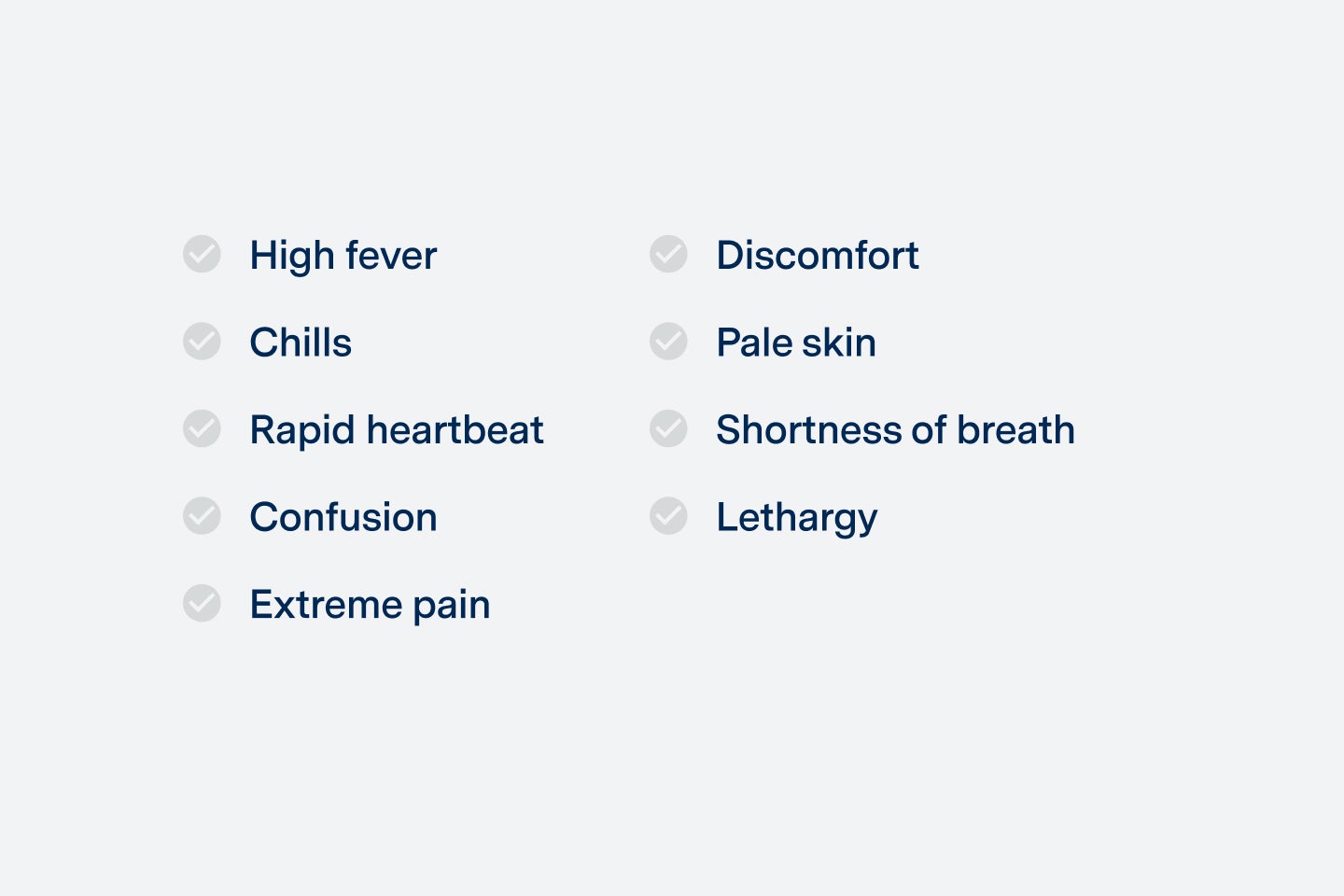Dental abscess: Causes and treatment
Explore the signs and solutions for dental abscesses to maintain your oral health
Dealing with dental abscess can be painful. Understanding your condition and how to treat it is important for keeping your smile happy, healthy and pain-free. When left untreated, dental abscesses threaten overall systemic health. At Aspen Dental, we’re here to guide you through understanding and treating dental abscesses as early as possible.
What is a dental abscess?
Dental abscesses are serious bacterial infections that occur at the root of a tooth or in the gums. These infections lead to the accumulation of pus and can cause severe pain and discomfort. There are three main types:

Tooth abscess (periapical)
These occur at the tip of the tooth’s root and usually result from an infection in the tooth pulp.

Periodontal abscess
These abscesses form in the gums at the side of a tooth root due to inflammation or infection in the gums.

Gingival abscess
A gingival abscess is a localized collection of pus within the gum tissue, caused by a bacterial infection from a foreign body, gum disease, or injury to the gum.
Tooth abscess and gum abscess symptoms
There are quite a few symptoms that may persist from this infection, and many can be painful:
Persistent, throbbing toothache and discomfort, hard to ignore.
Noticeable swelling in the face or gums, often visible.
Increased sensitivity to hot or cold foods and drinks, along with pressure.
Unpleasant taste in the mouth or consistent bad breath, and
Possible visual signs of infection, like pus or a small pimple on the gums.
Stages of a tooth abscess
Tooth decay
Early signs of tooth decay can sneak up on you, manifesting as sensitivity to hot or cold foods, mild discomfort when biting, and those pesky little pits or discolorations on the tooth’s surface.
Pulp infection
When decay advances and reaches the tooth pulp, it can cause intense pain and infection. This stage affects the nerves and blood vessels inside the tooth, making it extremely painful and often leading to swelling.
Abscess formation
An untreated pulp infection can escalate into an abscess. This stage may bring a visible abscess, and sometimes throbbing, discomfort, or fever, signaling that the infection is getting serious.
Causes of dental abscesses
Tooth decay & gum disease
Advanced tooth decay and gum disease can lead to bacterial infections that invade the tooth pulp.
Previous dental procedures
Trauma to the pulp of the tooth from deep restorations, or increased bacteria leakage points around the edges can lead to dental abscesses.
Exposure factors
Frequent snacking, a sugary diet, and dry mouth can speed up decay and gum disease, raising the risk of abscesses.
Treatment options for dental abscesses

Immediate relief and care for symptoms
For immediate relief and pain management from dental issues, consider using over-the-counter pain relievers and a salt-water rinse. Additionally, avoid hot foods and opt for soft, cooler foods that are less likely to aggravate your pain.

Professional dental treatments
The fastest and most effective way to treat a dental abscess is through professional dental care. Effective treatment options include professional drainage of the abscess, root canal treatments, an apicoectomy (surgery to remove the infected root tip if the infection persists), or tooth extractions to prevent further damage, and antibiotics to clear up the infection.

Follow up care and recovery
Routine dental check-ups will monitor your recovery and ensure your infection stays away. Your dentist will recommend oral hygiene practices and products that will help your healing process and to prevent infections in the future.

Preventing dental abscess
To prevent dental abscesses, it’s important to keep a diligent oral hygiene routine and have your Aspen Dental dentist promptly evaluate any broken or chipped teeth or infection and cavities, as soon as they are detected. These can become entry points for bacteria to infect the tooth root or gums, leading to abscesses. Regular check-ups ensure potential issues are addressed before they escalate.

When to seek immediate medical attention?
It’s important to know the warning signs and symptoms of a spreading infection. Signs of serious complications may include swelling that can cause eye pressure or closure, trouble swallowing and breathing, as well as the following shown in this graphic:
If you have a dental abscess and begin to experience these symptoms, it is best to seek immediate care, as you could be experiencing sepsis or a heightened infection.
Dental abscess FAQs
Can dental abscess go away on its own?
No, dental abscesses do not go away on their own. Abscesses require professional treatment to drain the infection and prevent serious complications. Ignoring an abscess may lead to the spread of infection.
How do dentists get rid of dental abscess?
Dentists may treat dental abscesses by draining the pus to relieve the infection. Your dental professional may incorporate antibiotics into your treatment to minimize the infection, a root canal to save the affected tooth or even a tooth extraction if the tooth cannot be saved. The right treatment for you will depend a number of factors, including how severe your abscess is.
Is an abscess a dental emergency?
Yes, an abscess can be a dental emergency. If you are experiencing symptoms seek immediate dental care. Abscesses can lead to more life-threatening infections such as sepsis if not taken care of properly.
What is the difference between a tooth abscess and a tooth infection?
A tooth infection can encompass any infection in the tooth, gums or surrounding areas, often resulting from cavities or gum disease. A tooth abscess is a specific kind of infection where pus forms due to bacterial activity, typically located at the tooth root or in adjacent gums.
Are dental abscesses contagious?
Dental abscesses are not contagious and cannot be spread directly from one person to another. An abscess is a localized infection in the mouth that involves pus caused by bacteria. While the bacteria that cause the infection can be present in saliva, the abscess itself, being an isolated pocket of infection, doesn't spread through casual contact such as kissing or sharing utensils.
Explore our dental services and more
Keep your smile bright and healthy
Remember, maintaining good oral hygiene and regular dental check-ups at an Aspen Dental near you can help prevent such issues and keep your smile healthy and bright.
